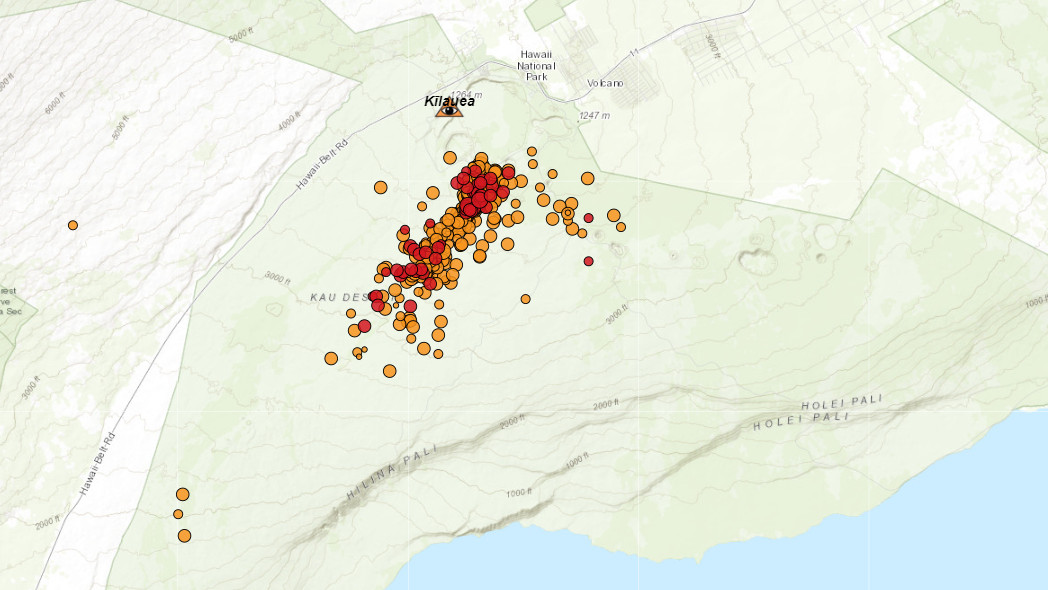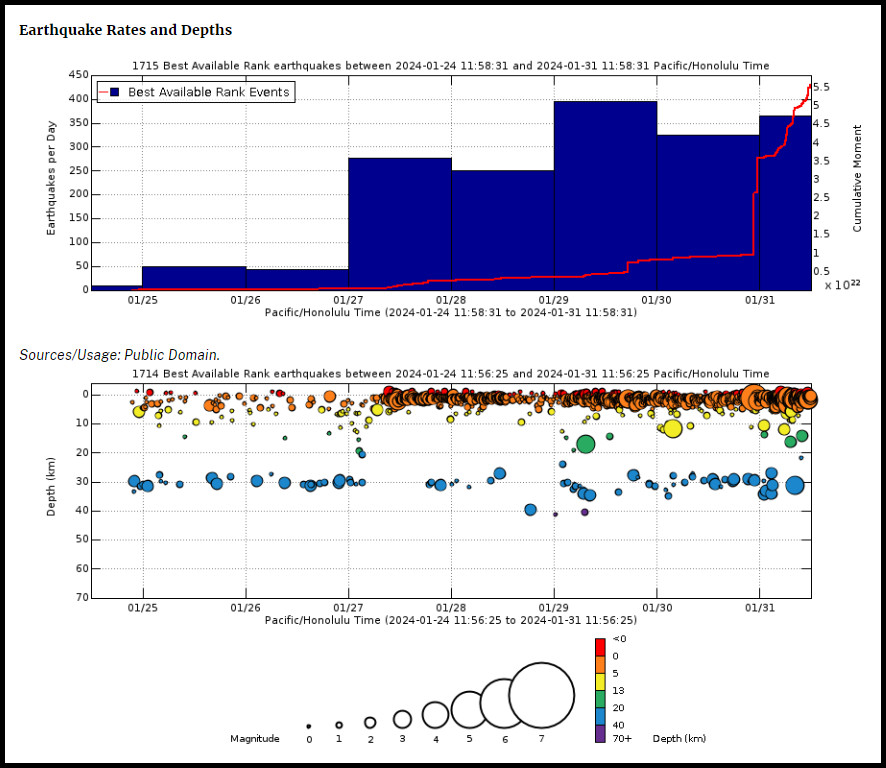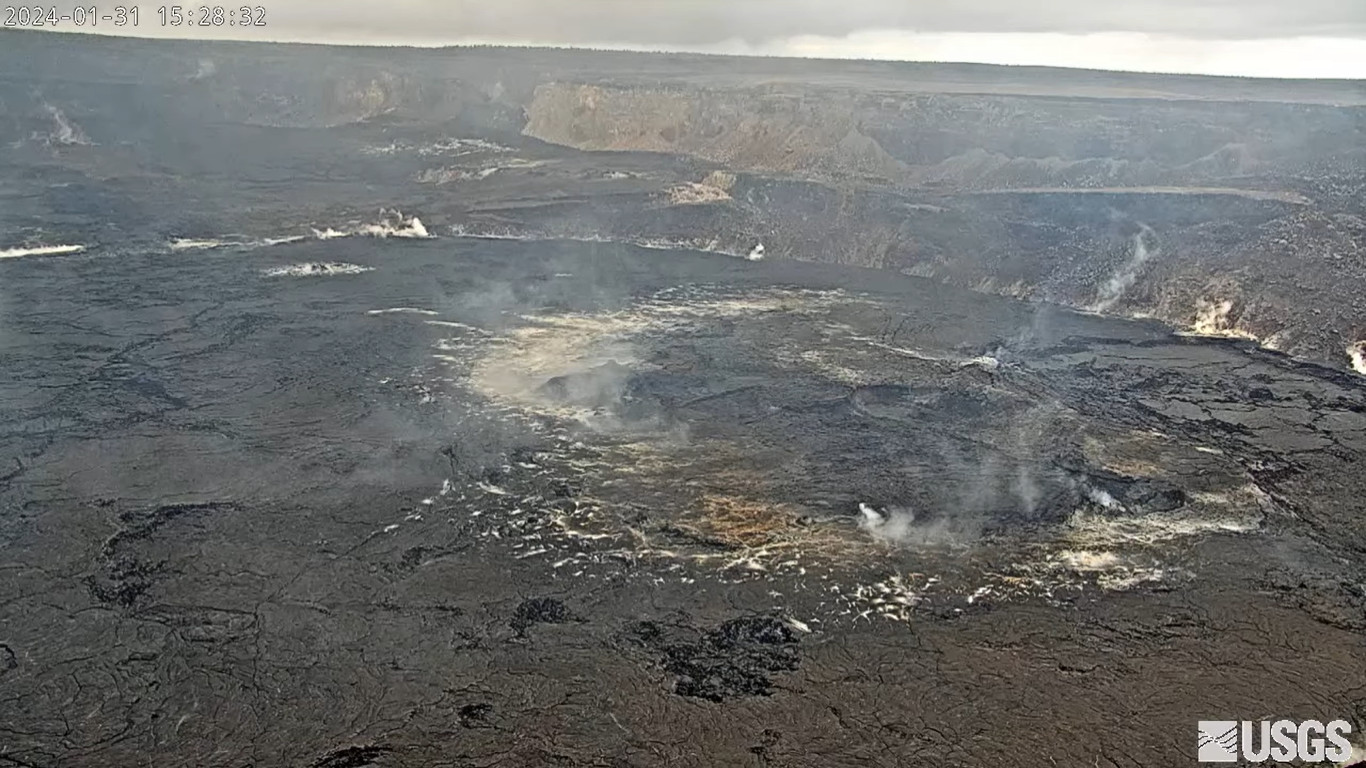
image from interactive USGS map showing the location of the latest earthquake activity south of the Kīlauea caldera on Wednesday afternoon.
(BIVN) – Kīlauea volcano is not erupting, as the rise in earthquake rates and ground deformation that triggered an increased alert level this morning, has continued into Wednesday evening.
The increase in seismicity in the south caldera region “has remained at high levels since 3 a.m. HST,” reported the USGS Hawaiian Volcano Observatory, which noted that “an eruption could occur in the future with little warning.” The Kīlauea alert level was raised from ADVISORY to WATCH today.
Hawaiʻi Volcanoes National Park remains open and no new closures have been announced due to the elevated volcanic unrest.
Following a Volcanic Activity Notice issued on Wednesday morning, USGS HVO scientists followed up with this daily update:
Summit Observations: Seismicity began to increase just before midnight. Since 3 a.m. HST, 25-30 locatable earthquakes have occurred per hour at depths of 1.5–3 km (1–2 mi) below the surface. Earthquake clusters have migrated between the area just south of Halemaʻumaʻu and the region southwest of the outer caldera boundary. The most intense activity occurred between 6 and 8 a.m., when earthquakes were clustering just south of Halemaʻumaʻu. There have been over 180 locatable earthquakes in this region in the past 6 hours, with magnitudes ranging from a maximum of 3.4 to less than 1. Several of these earthquakes were large enough to be felt by HVO staff in the field, who also reported rockfalls on the south side of Halemaʻumaʻu.
At the time of this report, earthquake activity remains elevated, and the overall number and intensity of earthquakes is fluctuating with time. Periods of increased seismicity can be expected to continue during repressurization of the summit magma reservoir, which has been ongoing since the end of the September 2023 eruption.
Kīlauea’s summit region remains at a high level of inflation. Nearly 10 microradians of change have been recorded since 4:00 a.m. HST at tiltmeters near Sand Hill and Uēkahuna bluff. Both of these tiltmeters have shown highly variable directions and rates of tilt, typical of shallow crack growth that can precede either an eruption or shallow intrusion. Step-wise changes in the tilt signal are likely due to the instrument being shaken by nearby earthquakes or rockfalls.

(From the USGS HVO) Above Top: Number of earthquakes per day during the past week (blue bars). The red line is the cumulative moment (energy) release. Bottom: Depth of earthquakes during the past week in the area shown on the map above. Depth is reported relative to sea level, which is equal to a depth of zero on the above plot. On both figures, circle-size represents magnitude, and color indicates depth.
Sulfur dioxide (SO2) gas emission rates remain low. Field measurements indicated an SO2 emission rate of approximately 70 tonnes per day on January 17, which was similar to measurements in October, November, and early December.
Patterns of ground deformation and earthquakes since this morning indicate that pulses of magma continue to move beneath the surface of the region south-southwest of Kīlauea’s summit. HVO is closely monitoring Kīlauea volcano, watching for any signs of accelerated rates of earthquakes or ground deformation, or signs of shallowing earthquake locations, which usually precede a new outbreak of lava or propagating dike. We are also closely monitoring gas emissions and webcam imagery.
Scientists noted that seismicity in Kīlauea’s East Rift Zone and Southwest Rift Zone remained low in the past 24 hours.


by Big Island Video News4:40 pm
on at
STORY SUMMARY
HAWAIʻI VOLCANOES NATIONAL PARK - The uptick in unrest that triggered an increase in the volcano alert level for Kīlauea has continued throughout Wednesday.